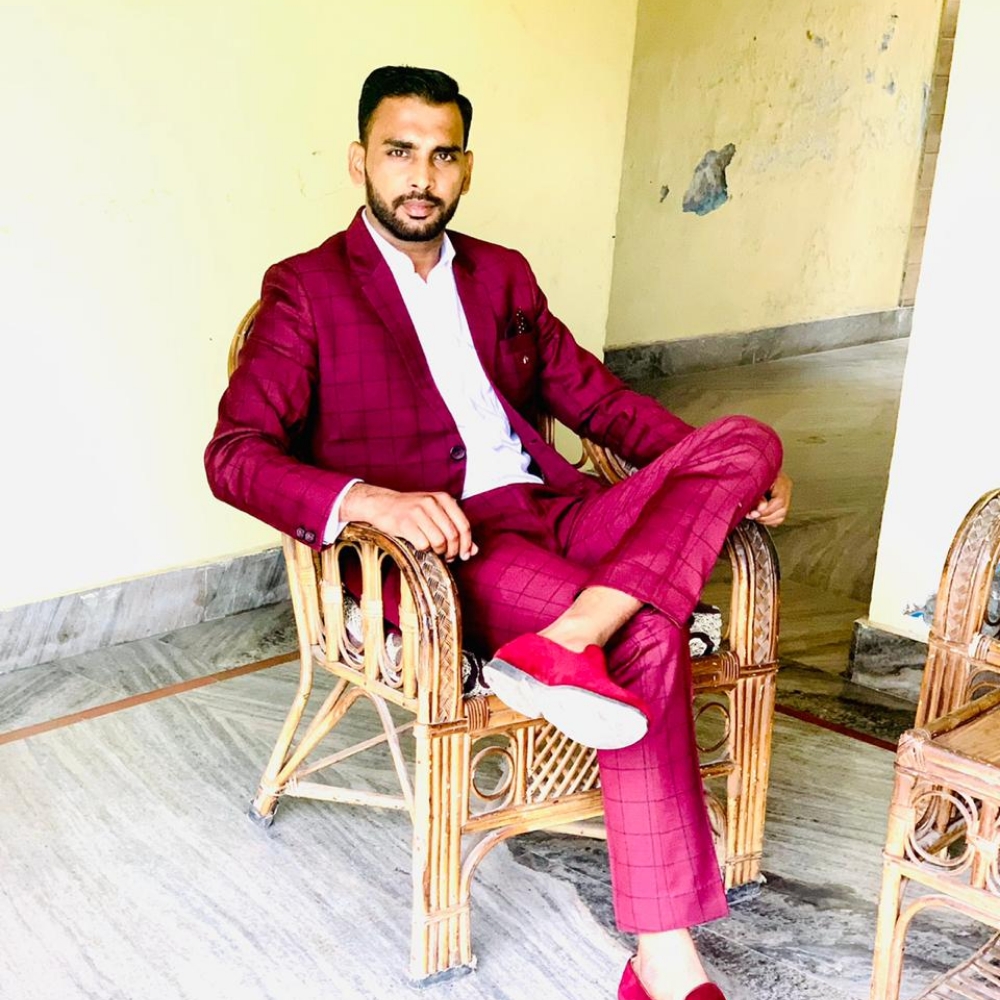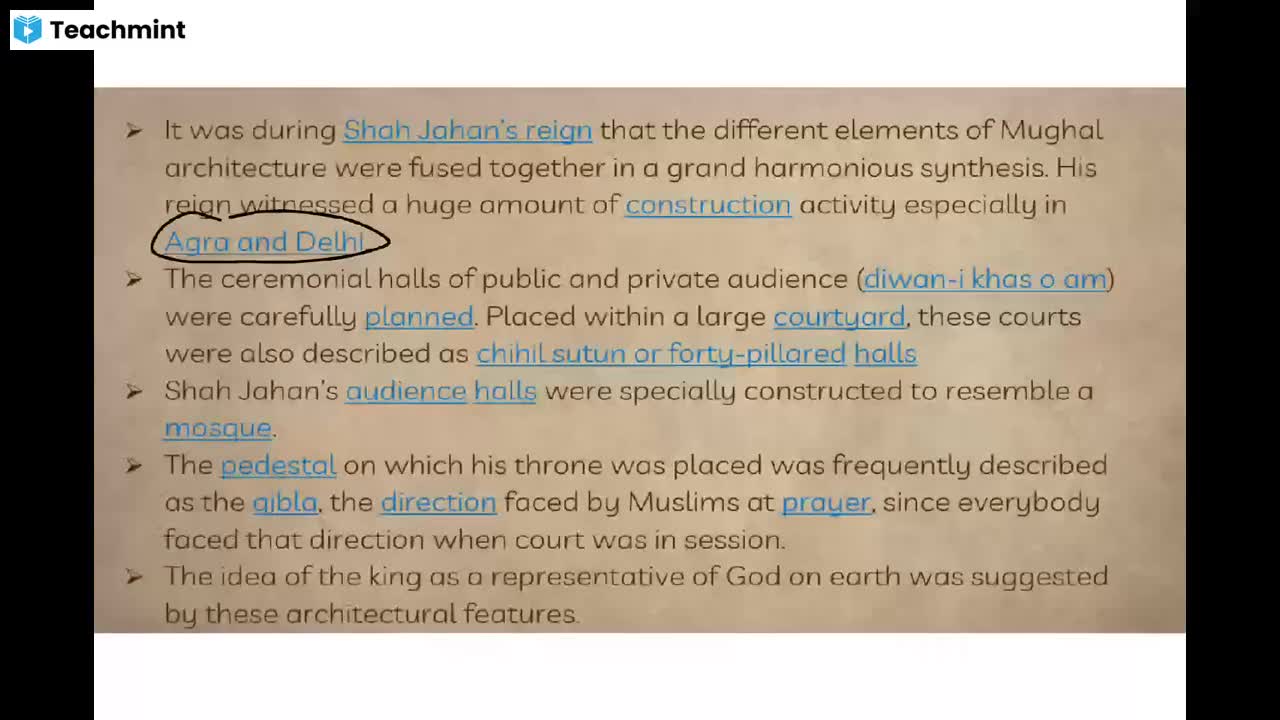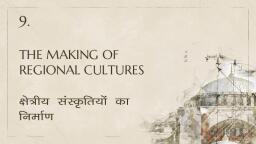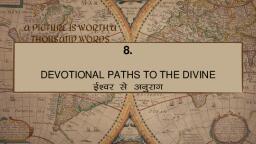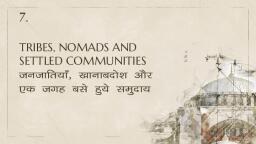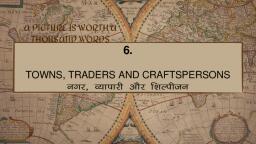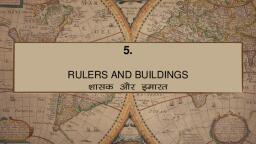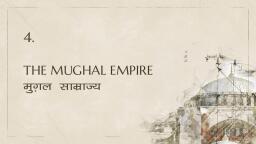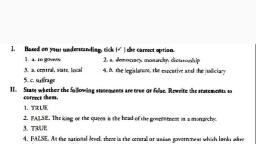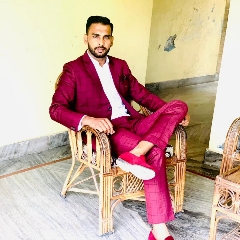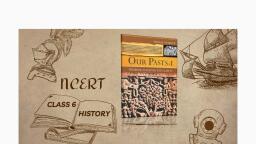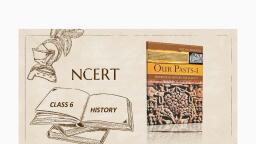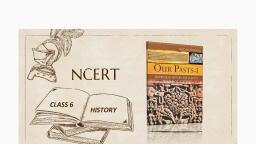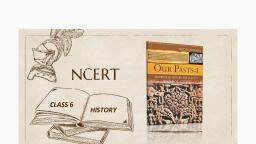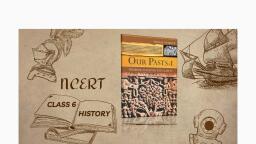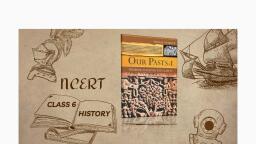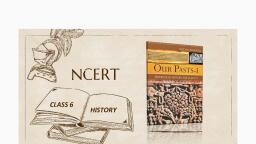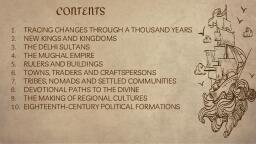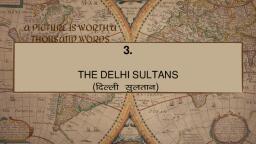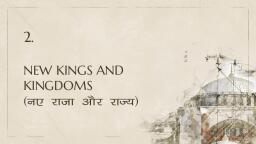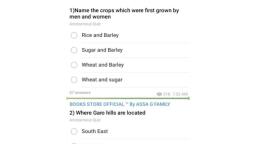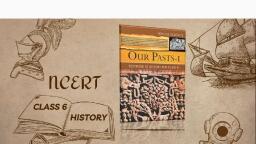Page 2 :
CONTENTS, 1., 2., 3., 4., 5., 6., 7., 8., 9., 10., 11., , WHAT, WHERE, HOW AND WHEN ?, FROM HUNTING–GATHERING TO GROWING FOOD, IN THE EARLIEST CITIES, WHAT BOOKS AND BURIALS TELL US., KINGDOMS, KINGS AND AN EARLY REPUBLIC, NEW QUESTIONS AND IDEAS, ASHOKA, THE EMPEROR WHO GAVE UP WAR, VITAL VILLAGES, THRIVING TOWNS, TRADERS, KINGS AND PILGRIMS, NEW EMPIRES AND KINGDOMS, . BUILDINGS, PAINTINGS AND BOOKS
Page 3 :
A PICTURE IS WORTH A, THOUSAND WORDS, , 1., , WHAT, WHERE, HOW AND, WHEN ?
Page 4 :
OVERVIEW ?, 1., 2., 3., 4., 5., 6., , What can we know about the past ?, Names of the land, Where did people live ?, Finding out about the past \, One past or many ?, What do dates mean ?
Page 5 :
WHAT CAN WE KNOW ABOUT THE PAST ?, ● What people ate,, ● The kinds of clothes they wore,, , The houses in which they lived., ● The lives of hunters, herders, farmers, rulers,, merchants, priests, crafts persons, artists, musicians,, and scientists., ●
Page 7 :
PEOPLE TRAVELLED BECAUSE :1. In search of livelihood, 2. Escape natural disasters, 3. Conquering other lands, 4. Trade, 5. Religious teachings, 6. Spirit of Adventure.
Page 8 :
NAMES OF THE LAND : The word India comes from the Indus, called, , Sindhu in Sanskrit., The Iranians and the Greeks who came through, the northwest about 2500 years ago and were, familiar with the Indus, called it the Hindos or the, Indos, and the land to the east of the river was, called INDIA., The name Bharata was used for a group of people, who lived in the northwest, and who are, mentioned in the Rigveda, the earliest composition, in Sanskrit (dated to about 3500 years ago)
Page 9 :
MANUSCRIPTS : They were written by hand (this comes from the Latin word ‘manu’,, , , , , , , meaning hand)., These were usually written on palm leaf, or on the specially prepared, bark of a tree known as the birch, which grows in the Himalayas., Preserved in temples and monasteries., These books dealt with all kinds of subjects:, religious beliefs and practices, the lives of kings, medicine and science., Besides, there were epics, poems, plays., Many of these were written in Sanskrit, others were in Prakrit, (languages used by ordinary people) and Tamil.
Page 10 :
INSCRIPTIONS : These are writings on relatively hard surfaces such as stone or metal., Sometimes, kings got their orders inscribed so that people could see,, , read and obey them. There are other kinds of inscriptions as well,, where men and women (including kings and queens) recorded what, they did., For example, kings often kept records of victories in battle., ● When we write anything, we use a script., ● Scripts consist of letters or signs. When we read what is written, or, , speak, we use a language.
Page 11 :
This inscription dates to about 2250 years ago,, , and was found in Kandahar, present-day, Afghanistan. It was inscribed on the orders of, a ruler named Ashoka., This inscription was inscribed in two different, scripts and languages, Greek (top) and, Aramaic (below), which were used in this area
Page 12 :
ARCHAEOLOGISTS : Those who study many other things, , that were made and used in the past., They study the remains of buildings made of stone and brick, paintings, , and sculpture., They also explore and excavate (dig under the surface of the earth) to, find tools, weapons, pots, pans, ornaments and coins., Some of these objects may be made of stone, others of bone, baked, clay or metal.
Page 13 :
ONE PAST OR MANY ?, Past was different for different groups of people ., E.G. lives of herders or farmers were different from those of kings and, , queens, the lives of merchants were different from those of crafts, persons., Even today most people living in the Andaman Islands get their own, food by fishing, hunting, and collecting forest produce. By contrast,, most people living in cities depend on others for supplies of food.
Page 14 :
WHAT DO DATES MEAN ?, Years are counted from the date generally assigned to the birth of, , , , , , , Jesus Christ, the founder of Christianity., BC, stands for ‘Before Christ.’, AD,stands for two Latin words, ‘Anno Domini’, meaning ‘in the year, of the Lord’ (i.e. Christ)., Sometimes CE is used instead of AD and BCE instead of BC., The letters CE stand for ‘Common Era’ and BCE for ‘Before Common, Era’., We use these terms because the Christian Era is now used in most, countries of the world.
Page 15 :
DECIPHERMENT ?, Process of understanding inscription., E. G., Rosetta, Egypt, (Country of N. Africa), An inscribed stone was found, which contained, inscriptions in three different languages and, scripts (Greek, and two forms of Egyptian)., The names of kings and queens were enclosed in, a little frame, called a CARTOUCHE.
Page 16 :
TAKEAWAYS, MATCH THE FOLLOWING :Narmada Valley, , The first big kingdom, , Magadha, , Hunting and gathering, , Garo hills, , Cities about 2500 years ago, , Indus and its, tributaries, , Early agriculture, , Ganga Valley, , The first cities
Page 17 :
THANKS !
Page 19 :
2., FROM HUNTING–, GATHERING TO, GROWING FOOD
Page 20 :
OVERVIEW, 1., 2., 3., 4., 5., 6., , 4, , The earliest people: why were they on the y on they on the move ?, How do we know about these people ?, Choosing a place to live in ., The beginning of farming and herding ., A new way of lify of lif y of life ., Towards a settled life .
Page 21 :
hunter-gatherers, ⬗, , They hunted wild animals, caught fish and birds, gathered fruits, roots, nuts, seeds,, leaves, stalks and eggs., , ⬗, 1., 2., , Hunter-gatherers moved from place to place. There are many reasons for this:-, , 3., 4., , 5, , Had to go elsewhere in search of food., Animals move from place to place — either in search of smaller prey, or, in the case of, deer and wild cattle, in search of grass and leaves. That is why those who hunted them, had to follow their movements., Moved from season to season in search of different kinds of plants., Many rivers and lakes are perennial (with water throughout the year) others are, seasonal. People living on their banks would have had to go in search of water during, the dry seasons (winter and summer).
Page 22 :
How do we know about these people?, ⬗ It is likely that people made and used tools of stone, wood and bone, ⬗ Used to cut meat and bone, scrape bark (from trees) and hides (animal skins),, chop fruit and roots, to make spears and arrows for hunting., ⬗ Other tools were used to chop wood, which was used as firewood. Wood was, also used to make huts and tools., , 6
Page 23 :
⬗ Archaeologists have found evidence of huntergatherers. ( PLACES WITH BLACK, TRIANGLES ), ⬗ Many sites were located near sources of water,, such as rivers and lakes, places where good, quality stone was easily available, , 7
Page 24 :
TECHNIQUES OF MAKING STONE TOOLS!, 1. STONE ON STONE :- One stone used, as hammer on another., 2. PRESSURE FLAKING :- Core, placed on firm surface and hammer, stone used to remove flakes., , 8
Page 25 :
PATNE, MAHARASHTRA :- OSTRICHES SHELL, Found in patne, Maharashtra, Paleolithic period, Ostrich shells- designed and used for beads, , 9
Page 26 :
SITES, ⬗ Places where the remains of things (tools, pots, buildings etc.) were found., ⬗ These were made, used and left behind by people. These may be found on, the surface of the earth, buried under the earth, or sometimes even under, water., , ⬗ E.G. an old site with caves and rock shelters., , 10
Page 27 :
BHIMBETKA, ⬗ (in present day Madhya Pradesh)., These rock shelters are close to the Narmada valley, ⬗ People chose these natural caves because they provided, shelter from the rain, heat and wind., ⬗ Many caves have paintings on the walls ., , 11
Page 28 :
“, , KURNOOL CAVES, , Traces of ash have been found here. This, suggests that people were familiar with the, use of fire ., , 12
Page 29 :
“, , HUNSGI, , A number of early Paleolithic, sites were found here., Use of limestones was, prominent., contained stone tools and, weapons made from a reddishbrown chert., 13
Page 30 :
NAMES AND DATES :PALEOLITHIC, 2 million years ago to about 12,000, , years ago., Lower, Middle and Upper, , Palaeolithic, palaeo’, meaning old, and ‘lithos’,, , meaning stone, stone tools., , 14
Page 31 :
NAMES AND DATES :MESOLITHIC, 12,000 years ago till about 10,000 years, , ago, environmental changes, Stone tools found during this period are, , generally tiny, and are called microliths, As handles of bone or wood to make tools, , such as saws and sickles, , 15
Page 32 :
NAMES AND DATES :NEOLITHIC, 10,000 years ago, Farming and herding, Tools that were polished to give a fine, , cutting edge, and mortars and pestles used, for grinding grain and other plant produce., , 16
Page 33 :
17
Page 34 :
beginning of farming and herding :12,000 years ago, major changes in the climate of the world, shift to relatively, warm conditions., development of grasslands., increase in the number of deer, antelope, goat, sheep and cattle, i.e. animals, that survived on grass., Those who hunted these animals now followed them, learning about their, food habits and their breeding seasons. It is likely that this helped people to, start thinking about herding and rearing these animals themselves, , 18
Page 35 :
EVOLUTION :FOOD GATHERER, DOMESTICATION OFANIMALS, HUNTER, AGRICULTURE, 19
Page 36 :
FARMING, Several grain bearing grasses, including wheat, barley and rice grew naturally in, different parts of the subcontinent., HERDING AND DOMESTICATION, People could also attract and then tame animals by leaving food for them near, their shelters., The first animal to be tamed was the wild ancestor of the dog. Later, people, encouraged animals that were relatively gentle to come near the camps where, they lived. These animals such as sheep, goat, cattle and also the pig lived in, herds, and most of them ate grass., Often, people protected these animals from attacks by other wild animals., 20
Page 37 :
21
Page 38 :
A NEW WAY OF LIFE, Had to stay in the same place for a long time looking after the, plants, watering, weeding, driving away animals and birds — till, the grain ripened., As grain had to be stored for both food and seed, they began, making large clay pots, or wove baskets, or dug pits into the, ground., Animals multiply naturally. Besides, if they are looked after, carefully, they provide important source of food, and meat,, whenever required., 22
Page 39 :
TOWARDS A SETTLED LIFE, ⬗ Archaeologists have found traces of huts or houses at some sites., ⬗ Burzahom (in present-day Kashmir), people built pit-houses, which were dug into the ground, with steps leading, into them. These may have provided shelter in cold weather. also found cooking, hearths both inside and outside the huts., ⬗ Earthen pots have also been found. These were sometimes decorated, and were, used for storing things. People began using pots for cooking food, especially, grains like rice, wheat and lentils., , 23
Page 40 :
MEHRGARH, Located in a fertile plain, near the Bolan Pass, which is one of the, most important routes into Iran., Remains of square or rectangular houses. Each house had four or, more compartments, some of which may have been used for, storage., When people die, their relatives and friends generally pay respect, to them,in the belief that there is some form of life after death., Burial is one such arrangement., The dead person was buried with goats,, which were probably meant to serve as, food in the next world., 24
Page 41 :
DAOJALI HADING, On the hills near Brahmaputra valley, Near routes to china and Myanmar, Stone tools: mortars and pestles, Grow grain & prepare food, Jadeite, (stone brought from china ), Tools of fossil wood & pottery, 25
Page 42 :
A NEOLITCHIC SITE, CATAL HUYUK ,in Turkey., , Several things were brought from great distances —, flint from Syria,, cowries from the Red Sea,, shells from the Mediterranean Sea — and used in the settlement., There were no carts — most things would have been, carried on the backs of pack animals such as cattle or by people ., , 26
Page 43 :
Paleolithic cave paintings, LASCAUX,in FRANCE., , a Palaeolithic cave situated in southwestern France, near the village of, Montignac in the Dordogne region, Exceptional quality , size ,, Sophistication and antiquity., Estimated to be up to 20000 years old, The paintings consist primarily of large animals, E.G :, Aurochs – an older wild form of cattles, 27
Page 44 :
TAKEAWAYS, ⬗ TRUE OR FALSE :(a)Hunter-gatherers chose to live in caves and rock, shelters because they provided shelter from the rain,, heat and wind ., (b) Grasslands developed around 12,000 years ago.
Page 45 :
Thanks!, , 29
Page 47 :
3., IN THE EARLIEST CITIES, 3
Page 48 :
OVERVIEW, HOW WE CAME TO KNOW ABOUT IT ?, HARAPPA, MOHENJO DARO, KALIBANGAN AND LOTHAL, HOUSES, DRAINS AND STREETS, LIFE IN THE CITY, NEW CRAFTS IN THE CITY, RAW MATERIAL AND FOOD FOR PEOPLE IN THE CITIES, A CLOSER LOOK — HARAPPAN TOWNS IN GJ, SEALS AND SEALINGS, , 4
Page 49 :
“, , The Earliest, Cities in the, sub continent, , 5
Page 50 :
HOW WE CAME TO KNOW ABOUT IT??, British rule - construction of railway lines, British started excavation ., , 6
Page 51 :
HARAPPA, The first city to be discovered, all other sites, from where similar buildings (and other things) were found, were described as HARAPPA, , Cities were divided into two or more parts. Usually, the part to the, west was smaller but higher (Citadel ), , The part to the east was larger but lower. ( lower town )., Very often walls of baked brick were built around each part ( in an, interlocking pattern and that made the walls strong )., , 7
Page 52 :
MOHENJO DARO, In some cities, special buildings, were constructed on the CITADEL., , Great Bath, was built in this area. This was lined with bricks,, coated with plaster, and made water-tight with a layer of, natural tar. There were steps, while there were rooms on all, sides. Water was probably brought in from a well, and, drained out after use., , Perhaps important people took a dip in this tank on special, occasions., , 8
Page 53 :
KALIBANGAN AND LOTHAL, Had fire altars, where sacrifices may, have been performed ., , 9
Page 54 :
HOUSES, DRAINS AND STREETS, Houses were either one or two storeys high, with, rooms built around a courtyard., , Had a separate bathing area, and some had wells to, supply water., , Had covered drains. Each drain had a gentle slope so, that water could flow through it. Very often, drains in, houses were connected to those on the streets and, smaller drains led into bigger ones. Inspection holes were, provided at intervals to clean them., , 10
Page 55 :
LIFE IN THE CITY, RULERS :People who planned the construction of special buildings, kept the most valuable objects, such as ornaments of gold and silver, SCRIBES :People who knew how to write, who helped prepare the seals ., CRAFTS PERSON :Making all kinds of things — either in their own homes, or in special, workshops. travelling to distant lands or returning with raw materials and,, perhaps, stories. Many terracotta toys have been found and children must, have played with these., , 11
Page 56 :
NEW CRAFTS IN THE CITY, , Copper and bronze - used to make tools, weapons, ornaments., Gold and silver- used to make ornaments and vessels ., Also made seals out of stone ( generally rectangular and usually have an, animal carved on them )., The Harappans also made pots with beautiful black designs., 12
Page 57 :
NEW CRAFTS IN THE CITY, Actual pieces of cloth were found attached to the lid of a silver vase and, some copper objects at Mohenjodaro., Spindle whorls, made of terracotta and faience. These were used to spin, thread., Cotton in Mehrgarh.(Grown at Mehrgarh around 5000BC)., , 13
Page 58 :
IN SEARCH OF RAW MATERIALS, Copper from present-day Rajasthan, and even from Oman in West, Asia., , Tin, which was mixed with copper to produce bronze, - brought, from present-day Afghanistan and Iran., , Gold - from present-day Karnataka, and, Precious stones - from present-day Gujarat, Iran and Afghanistan., , 14
Page 59 :
FOOD FOR PEOPLE IN THE CITIES, ◈Farmers and herders supplied food to crafts persons, scribes and rulers in, the cities., , ◈Grew wheat, barley, pulses, peas, rice, sesame, linseed and mustard., ◈ A new tool, the plough, was used to dig the earth for turning the soil and, planting seeds., , ◈As this region does not receive heavy rainfall, some form of irrigation, may have been used., , ◈The Harappans reared cattle, sheep, goat and buffalo., 15
Page 60 :
A CLOSER LOOK — HARAPPAN TOWNS IN GJ, ◈ DHOLAVIRA was located on Khadir Beyt in the Rann of Kutch,, where there was fresh water and fertile soil., , ◈ Divided into three parts, and each part was surrounded with massive, stone walls, with entrances through gateways. There was also a large, open area in the settlement, where public ceremonies could be held, , ◈ Other finds include large letters of the Harappan script ,carved out of, white stone and perhaps inlaid in wood. This is a unique find as, generally Harappan writing has been found on small objects such as, seals., , 16
Page 61 :
LOTHAL stood beside a tributary of the, Sabarmati, in Gujarat, close to the Gulf of, Khambat., It was situated near areas where raw materials such as semi-precious stones, were easily available, for making objects out of stone, shell and metal., Huge tank may have been a dockyard, where boats and ships came in from, the sea and through the river channel. Goods were probably loaded and, unloaded here., , 17
Page 62 :
SEALS AND SEALINGS, , Seals may have been used to stamp bags or packets containing goods, that were sent from one place to another., After a bag was closed or tied, a layer of wet clay was applied on the, knot, and the seal was pressed on it., , A Harappan seal :- Those scripts is the earliest, form of writing known in the subcontinent ., , 18
Page 63 :
THE MYSTERY OF THE END, Sites in Sind and west Punjab (present-day Pakistan) were abandoned,, while many people moved into newer, smaller settlements to the east and, the south., SCHOLARS SUGGEST THAT :-, , 1. The rivers dried up, 2. There was deforestation, 3. In some areas there were floods., But none of these reasons can explain the end of all the cities., 19
Page 64 :
New cities emerged, about 1400 years, later.
Page 65 :
EGYPT, Kings sent armies to distant lands to get gold,, silver, ivory, timber, and precious stones., They also built huge tombs, known as pyramids. When they died, the, bodies of kings were preserved and buried in these pyramids ‘mummies’, Objects buried with them:- included food and drink, clothes, ornaments,, utensils, musical instruments, weapons and animals. Sometimes even, serving men and women were buried with the rulers ., 21
Page 66 :
TAKEAWAYS, MATCH THE COLUMN :Copper, Gold, Tin, Precious stones, , Gujarat, Afghanistan, Rajasthan, Karnataka, 22
Page 67 :
THANKS !
Page 69 :
A PICTURE IS WORTH A, THOUSAND WORDS, , 4., , WHAT BOOKS AND, BURIALS TELL US
Page 70 :
OVERVIEW ?, 1., 2., 3., 4., 5., , One of the oldest books in the world ., How historians study the Rigveda !, Cattle, horses and chariots., Silent sentinels—the story of the megaliths, Burials and Inamgaon
Page 71 :
ONE OF THE OLDEST BOOKS IN THE WORLD :, ● VEDAS, ● There are FOUR of them –, , the Rigveda, Samaveda, Yajurveda and Atharvaveda., ● The oldest Veda is the Rigveda, composed about 3500 years ago., includes more than a thousand hymns, called sukta or “well-said”., These hymns are in praise of various gods and goddesses., ● Three gods are especially important:\, Agni, the GOD OF FIRE;, Indra, a WARRIOR GOD; and, Soma, a plant from which a SPECIAL DRINK was prepared
Page 72 :
RIGVEDA :● Hymns were composed by sages (rishis). Priests, , taught students to recite and memorise each, syllable, word, and sentence, bit by bit, ● A few were composed by women. The Rigveda is, in old or Vedic Sanskrit, ● The Rigveda was recited and heard rather than, read. It was written down several centuries after, it was first composed, and printed less than 200, years ago.
Page 73 :
SANSKRIT :● Sanskrit is part of a family of languages known as Indo-European., ● Some Indian languages such as Assamese, Gujarati, Hindi, Kashmiri and, , Sindhi; Asian languages such as Persian and many European languages, such as English, French, German, Greek, Italian and Spanish belong to this, family., ● They are called a family because they originally had words in common., Take the words ‘matr’ (Sanskrit), ‘ma’ (Hindi) and ‘mother’ (English), ● North-east belong to the Tibeto-Burman family;, ● Tamil, Telugu, Kannada and Malayalam belong to the Dravidian family;, ● languages spoken in Jharkhand and parts of central India belong to the, , Austro-Asiatic family
Page 74 :
HOW HISTORIANS STUDY THE RIGVEDA : Historians, like archaeologists, find out about the past, but, in addition, , to material remains, they examine written sources as well., Some of the hymns in the Rigveda are in the form of dialogues., E.G , a dialogue between a sage named, , Vishvamitra, and two rivers, (Beas and Sutlej) that, were worshipped as goddesses.
Page 75 :
CATTLE, HORSES AND CHARIOTS : There are many prayers in the Rigveda for cattle, children (especially, , sons), and horses., Horses were yoked to chariots that were used in battles, which were, , fought to capture cattle. (for land, which was important for pasture, and, for growing hardy crops that ripened quickly, such as barley. )(for, water, and to capture people.), Some of the wealth that was obtained was kept by the leaders, some, , was given to the priests and the rest was distributed amongst the, people.
Page 76 :
Some wealth was used for the performance, of yajnas or sacrifices in which offerings, were made into the fire. These were meant, for gods and goddesses. Offerings could, include ghee, grain, and in some cases,, animals.
Page 77 :
WORDS TO DESCRIBE PEOPLE : Some of the words used to describe people found in the Rigveda., There are two groups who are described in terms of their work —, , the PRIESTS, sometimes called brahmins, who performed various rituals,, the RAJAS.( these rajas were not like the ones you will be learning about, later. They did not have capital cities, palaces or armies, nor did they collect, taxes )., Two words were used to describe the people or the community as a whole., One was the word JANA, which we still use in Hindi and other languages., The other was VISH. The word vaishya comes from vish
Page 78 :
Sometimes, the people who composed the hymns described themselves as, , ARYAS and called their opponents Dasas or Dasyus., DASAS :- These were people who did not perform sacrifices, and, , probably spoke different languages., Later, the term dasa (and the feminine dasi) came to mean slave. Slaves, , were women and men who were often captured in war. They were treated, as the property of their owners, who could make them do whatever work, they wanted .
Page 79 :
SILENT SENTINELS—THE STORY OF THE MEGALITHS : These stone boulders are known as megaliths, , (literally big stones)., These were carefully arranged by people, and, , were used to mark burial sites., The practice of erecting megaliths began, , about 3000 years ago,, prevalent throughout the Deccan, south India,, , in the north-east and Kashmir.
Page 80 :
SILENT SENTINELS—THE STORY OF THE MEGALITHS : While some megaliths can be seen on the surface,, other megalithic burials are often underground., Sometimes, archaeologists find a circle of stone boulders, or a single large stone standing on the ground., These are the only indications that there, , are burials beneath.
Page 81 :
The dead were buried with distinctive pots, which are, , called Black and Red Ware. ( COMMON FEATURES :also found are tools and weapons of iron and, sometimes, skeletons of horses, horse equipment and, ornaments of stone and gold )., , This type of megalith is known as a CIST. Some, cists, like the one shown here, have port-holes, which could be used as an entrance.
Page 82 :
FINDING OUT ABOUT SOCIAL DIFFERENCES: Sometimes, more objects are found in one grave, , than in another ., E.G. Brahmagiri, HERE one skeleton was buried with 33 gold beads,, , 2 stone beads, 4 copper bangles, and one conch shell., Other skeletons have only a few pots., These finds suggest that there was some difference, in status amongst the people who were buried. Some, were rich, others poor, some chiefs, others followers
Page 83 :
WERE SOME BURIAL SPOTS MEANT FOR CERTAIN FAMILIES ?, Sometimes, megaliths contain more than one skeleton., These indicate that people, perhaps belonging to the same family, were, , buried in the same place though not at the same time., The bodies of those who died later were brought into the grave through, the portholes., Stone circles or boulders placed on the surface, probably served as signposts to find the burial, site, so that people could return to the same, place whenever they wanted to .
Page 84 :
BURIAL AT INAMGAON, Site on the river Ghod, a tributary of the Bhima., It was occupied between 3600 and 2700 years ago., Here, adults were generally buried in the ground,, , laid out straight, with the head towards the north., Sometimes burials were within the houses., Vessels that probably contained food and water, were placed with the dead., One man was found buried in a large, four legged, clay jar in the courtyard of a five-roomed house (one, of the largest houses at the site), in the centre of the, settlement. This house also had a granary. The body, was placed in a crosslegged position.
Page 85 :
OCCUPATION AT INAMGAON, Found seeds of wheat, barley, rice, pulses, millets, peas and sesame., Bones of a number of animals, many bearing cut marks that show they, , may have been used as food, have also been found., These include cattle, buffalo, goat, sheep, dog, horse, ass, pig, sambhar,, spotted deer, blackbuck, antelope, hare, and mongoose, besides birds,, crocodile, turtle, crab and fish., There is evidence that fruits such as ber, amla, jamun, dates and a variety, , of berries were collected.
Page 86 :
Famous physician named CHARAKA, who wrote a book on medicine known as the, Charaka Samhita., There he states that the human body has 360, bones. This is a much larger number than the, 200 bones that are recognised in modern, anatomy., Charaka arrived at this figure by counting the, teeth, joints and cartilage
Page 87 :
CHINA, Around 3500 years ago, we find some of the first evidence of writing in, , China. These writings were on animal bones. These are called oracle bones,, because they were used to predict the future., Kings got scribes to write questions on the bones —The bones were then, put into the fire, and they cracked because of the heat. Then fortunetellers, studied these cracks, and tried to predict the future. As you may expect,, they sometimes made mistakes., These kings lived in palaces in cities ,, they did not know the use of iron
Page 88 :
TAKEAWAYS, MATCH THE FOLLOWING :-, , Sukta, Chariots, Yajna, Dasa, Megalith, , Stone boulder, Sacrifice, Well-said, Used in battles, Slave
Page 89 :
THANKS !
Page 91 :
A PICTURE IS WORTH A, THOUSAND WORDS, , 5., KINGDOMS, KINGS AND, AN EARLY REPUBLIC
Page 93 :
HOW SOME MEN BECAME RULERS ?, Rajas were probably chosen by the jana, the people., But, around 3000 years ago, Some men became as, rajas by performing very big sacrifices., E.G. THE ASHVAMEDHA or HORSE SACRIFICE ., A horse was let loose to wander freely and it was guarded by the raja’s men., If the horse wandered into the kingdoms of other rajas and they stopped it, they, had to fight., If they allowed the horse to pass, it meant that they accepted that the raja who, wanted to perform the sacrifice was stronger than them. These rajas were then, invited to the sacrifice, which was performed by specially trained priests, who, were rewarded with gifts.
Page 94 :
The raja was a central figure in these rituals. He often had a special seat, a throne, or a tiger skin., His charioteer, who was his companion in the battle field and witnessed his, exploits, chanted tales of his glory., His relatives, especially his wives and sons, had to perform a variety of minor, rituals. The other rajas were simply spectators who had to sit and watch the, performance of the sacrifice., Priests performed the rituals including the sprinkling of sacred water on the king., The ordinary people, the vish or vaishya, also brought gifts., However, some people, such as those who were regarded as shudras by the, priests, were excluded from many rituals.
Page 95 :
VARNAS, Many books that were composed in north India, especially in the areas drained by, the Ganga and the Yamuna, during this period (often called later Vedic, because, they were composed after the Rigveda ). These include the Samaveda, Yajurveda, and Atharvaveda, as well as other books., These were composed by priests,, and described :, how rituals were to be performed., contained rules about society.
Page 96 :
There were several different groups in society at this time —, , priests and warriors,, farmers, herders,, traders, crafts persons, labourers,, fishing folk, and forest people., Some priests and warriors were rich, as were some farmers and traders., , Others, including many herders, crafts persons, labourers, fishing folk, and hunters and gatherers, were poor., The priests divided people into four groups, called VARNAS.
Page 97 :
VARNAS, .., According to them, each varna had a different set of functions :, 1. Brahmins were expected to study (and teach) the Vedas, perform sacrifices and, receive gifts., 2. Rulers, also known as kshatriyas. They were expected to fight battles and protect, people., 3. Vish or the vaishyas ,were expected to be farmers, herders, and traders., (Both the kshatriyas and the vaishyas, could perform sacrifices), 4. Shudras, who had to serve the other, three groups and could not perform any, rituals.
Page 98 :
MANY PEOPLE DID NOT ACCEPT THE SYSTEM OF VARNA LAID DOWN BY THE, BRAHMINS : Some kings thought they were superior to the priests., Birth could not be a basis for deciding which varna people belonged to., There should be no differences amongst people based on occupation., Everybody should be able to perform rituals., Condemned the practice of untouchability., Also, there were many areas in the subcontinent, such as the north-east, where social, and economic differences were not very sharp, and where the influence of the priests, was limited
Page 99 :
JANAPADAS, Literally means the land where the jana set its, foot, and settled down, E.G. Purana Qila in Delhi,, Hastinapura near Meerut,U.P and, Atranjikhera, near Etah,U.P, people lived in huts., kept cattle as well as other animals., They also grew a variety of crops —, rice, wheat, barley, pulses, sugarcane, sesame, and mustard
Page 100 :
They made earthen pots., Some of these were grey in colour, others, were red., One special type of pottery found at these, sites is known as Painted Grey Ware ., These are extremely fine to touch, with a, nice, smooth surface., Perhaps these were used on special occasions,, for important people, and to serve special food
Page 101 :
MAHAJANAPADAS, About 2500 years ago, some, janapadas became more important, than others, and were known as, mahajanapadas., Most mahajanapadas had a capital, city, many of these were fortified (huge, walls of wood, brick or stone were built, around them ).
Page 102 :
FORTS WERE PROBABLY BUILT BECAUSE :, People were afraid of attacks from other kings and needed protection., Some rulers wanted to show how rich and powerful they were by building, really large, tall and impressive walls around their cities., Land and the people living inside the fortified area could be controlled more, easily by the king., Building such huge walls required a great deal of planning., Thousands, if not lakhs of bricks or stones had to be prepared., This in turn meant enormous labour, possibly, by thousands of men, women, and children., And resources had to be found for all of this.
Page 103 :
KAUSHAMBI, The fortification wall at Kaushambi., This is a picture of remains of a wall made of, brick, found near present-day Allahabad, (Uttar Pradesh)., A part of it was, probably built, about 2500 years ago.
Page 104 :
ARMY, The new rajas now began maintaining armies., Soldiers were paid regular salaries and maintained by the, king throughout the year., Some payments were probably made using punch marked, coins.
Page 105 :
TAXES : Instead of depending on occasional gifts brought by people, as in the, , case of the raja of the janapadas, they started collecting regular taxes, Taxes on crops were the most important (most people were farmers)., Usually, the tax was fixed at 1/6th of what was produced. This was, known as bhaga or a share., • There were taxes on crafts persons as well. (in the form of labour)., • Herders were also expected to pay taxes in the form of animals and, animal produce., • There were also taxes on goods that were bought and sold, through, trade., • And hunters and gatherers also had to provide forest produce to the raja.
Page 106 :
CHANGES IN AGRICULTURE : Two major changes in agriculture around this time., , The growing use of iron ploughshares., This meant that heavy, clayey soil could be turned over better than, with a wooden ploughshare, so that more grain could be produced., 2. People began transplanting paddy., This meant that instead of scattering seed on the ground, from, which plants would sprout, saplings were grown and then planted, in the fields. This led to increased production, as many more plants, survived. However, it was back breaking work., Generally, slave men and women, (dasas and dasis) and landless, agricultural labourers (kammakaras) had to do this work, 1.
Page 107 :
MAGADHA : Many rivers such as the Ganga and Son, , flowed through Magadha., This was important for, (a) transport,, (b) water supplies, (c) making the land fertile., Parts of Magadha were forested., Elephants, which lived in forest,could be captured and trained for the army., Forests also provided wood for building houses, carts and chariots., Besides, there were iron ore mines in the region that could be tapped to, make strong tools and weapons.
Page 108 :
Magadha had two very powerful rulers,, Bimbisara and Ajatasattu,, , used all possible means to conquer other janapadas., Mahapadma Nanda was another important ruler., , He extended his control up to the north-west part of the subcontinent., Rajagriha (present-day Rajgir) in Bihar was the capital of Magadha for, , several years., Later the capital was shifted to Pataliputra (present-day Patna).
Page 109 :
ALEXANDER : More than 2300 years ago, a ruler named Alexander, who lived in, , Macedonia in Europe, wanted to become a world conqueror., conquer parts of Egypt and West Asia, and came to the Indian, subcontinent, reaching up to the, banks of the Beas. When he wanted to, march further eastwards, his soldiers, refused. They were scared, as they, had heard that the rulers of India had, vast armies of foot soldiers, chariots, and elephant.
Page 110 :
VAJJI, Capital at Vaishali (Bihar), was under a different form of, , government, known as gana or sangha. In a gana or a, sangha there were not one, but many rulers., These rajas performed rituals together. They also met in, assemblies, and decided what had to be done and how,, through discussion and debate, However, women, dasas and, kammakaras could not participate, in these assemblies
Page 111 :
Both the Buddha and Mahavira belonged to ganas or sanghas., , Some of the most vivid descriptions of life in the sanghas can be, found in Buddhist book., “Ajatasattu and the Vajjis ”, , is an account of the Vajjis from the Digha Nikaya, a famous, Buddhist book, which contains some of the speeches of the Buddha., These were written down about 2300 years ago.
Page 112 :
Rajas of powerful kingdoms tried to conquer, , the sanghas., Nevertheless, these lasted for a very long time,, , till about 1500 years ago, when the last of the, ganas or sanghas were conquered by the, Gupta rulers,
Page 113 :
GREECE AND ATHENS, The people of Athens set up a form of government, which was called a, , democracy, which lasted for about 200 years., All free men over the age of 30 were recognised as full citizens., There was an assembly that met at least 40 times a year to decide on, important matters., All citizens could attend these meetings., Appointments for many positions were made through lottery. All those, who wanted to be chosen gave in their names, and then some were, selected through lottery., Citizens were expected to serve in the army and the navy.
Page 114 :
GREECE AND ATHENS, However, women were not considered citizens., Also, many foreigners, who lived and worked in Athens as merchants and crafts, persons did not have rights as citizens., Besides, there were several thousand slaves in Athens, who worked in mines,, fields, households and workshops. They too were not treated as citizens
Page 115 :
TAKEAWAYS, TRUE OR FALSE :Rajas who let the ashvamedha horse pass through their, lands were invited to the sacrifice., The charioteer sprinkled sacred water on the king., Pots to store grain were made out of Painted Grey Ware.
Page 116 :
THANKS !
Page 118 :
6., NEW QUESTIONS AND, IDEAS
Page 119 :
OVERVIEW, 1. The story of the Buddha, 2. The stupa at Sarnath, 3. The story of Kisagotami, , 4
Page 120 :
The story of the Buddha, ⬗, , Siddhartha, also known as Gautama, the founder of, Buddhism, was born about 2500 years ago., , ⬗, , New cities were developing, and life was changing, in the villages as well, The Buddha belonged to a small gana known as the Sakya, gana, and was a kshatriya. When he was a young man, he left, the comforts of his home in search of knowledge., decided to find his own path to realisation, and meditated for, days on end under a peepal tree at Bodh Gaya in Bihar, where, he attained enlightenment. After that, he was known as the, Buddha or the Wise One., 5, , ⬗
Page 121 :
⬗ He then went to Sarnath, near Varanasi, where he taught for the first time. He, ⬗, ⬗, ⬗, ⬗, 6, , spent the rest of his life travelling on foot, going from place to place, teaching, people, till he passed away at Kusinagra, The Buddha taught that life is full of suffering and unhappiness. This is caused, because we have cravings and desires (which often cannot be fulfilled)., The Buddha described this as thirst or tanha. He taught that this constant, craving could be removed by following moderation in everything., Taught people to be kind, and to respect the lives of others, including animals., He believed that the results of our actions (called karma), whether good or bad,, affect us both in this life and the next., Encouraged people to think for themselves rather than to simply accept what he, said
Page 122 :
The stupa at Sarnath, This building, known as a stupa, was built, to mark the place where the Buddha first, taught his message., The Buddha taught in the language of the, ordinary people, Prakrit, so that everybody, could understand his message., 7
Page 123 :
The story of Kisagotami, Famous story about the Buddha, Woman named Kisagotami, whose son had died., The Buddha said: “Bring me a handful of mustard seeds, and I will, bring your child back to life.” “The seeds must come from the, house of a family where nobody has died.”, she found out that, someone or the other had died, , 8
Page 124 :
Upanishads, ⬗ other thinkers also tried to find answers, , , , , to difficult questions :wanted to know about life after death,, wanted to know why sacrifices should be performed., thinkers felt that there was something permanent in the universe that, would last even after death. They described this as the atman or the, individual soul and the brahman or the universal soul., They believed that ultimately, both the atman and the brahman were one., Many of their ideas were recorded in the Upanishads. These were part of the, later Vedic texts., , 9
Page 125 :
⬗ Most Upanishadic thinkers were men, especially brahmins and rajas., Occasionally, there is mention of women thinkers, such as Gargi, who was, famous for her learning, and participated in debates held in royal courts., ⬗ Poor people rarely took part in these discussions., ⬗ One famous exception was Satyakama Jabala, who was named after his mother,, the slave woman Jabali. He had a deep desire to learn about reality, was accepted, as a student by a brahmin teacher named Gautama,, and became one of the best-known thinkers of the, time. Many of the ideas of the Upanishads were later, developed by the famous thinker Shankaracharya,, , 10
Page 126 :
THE WISE BEGGAR, ⬗ Based on a story from one of the most famous, Upanishads, the Chhandogya Upanishad., ⬗ Shaunaka and Abhipratarin were two sages who, worshipped the universal soul, BEGGAR SAID :- “Then, O sages, by not giving, me food, you are actually denying food to the, universal soul.”, The sages realised the truth of what the beggar, said, and shared their food with him., 11
Page 127 :
Panini, the grammarian, Panini, who prepared a grammar for Sanskrit. He arranged the, , vowels and the consonants in a special order, and then used these, to create formulae like those found in, Algebra., He used these to write down the rules of, , the language in short formulae (around, 3000 of them!)., 12
Page 128 :
Jainism, The last and 24th tirthankara of the Jainas,, Vardhamana Mahavira, also spread his message, around this time, i.e. 2500 years ago. He was a, kshatriya prince of the Lichchhavis, a group that was, part of the Vajji sangha., At the age of thirty, he left home and went to live in a forest. For twelve years, he led a hard and lonely life, at the end of which he attained enlightenment., , 13
Page 129 :
Jainism, He taught a simple doctrine:, men and women who wished to know the truth must leave their homes. They, must follow very strictly the rules of ahimsa, which means not hurting or, killing living beings., “All beings,” said Mahavira “long to live. To all things life is dear.”, Used Prakrit (Prakrit spoken in Magadha was known as Magadhi), , 14
Page 130 :
Followers of Mahavira, who were known as Jainas, had to, lead very simple lives, begging for food. They had to be, absolutely honest, and were especially asked not to steal. Also,, they had to observe celibacy. And men had to give up everything,, including their clothes., Jainism was supported mainly by traders. Farmers, who had to, kill insects to protect their crops, found it more difficult to follow the rules., Over hundreds of years, Jainism spread to different parts of north India, and to, Gujarat, Tamil Nadu and Karnataka., 15
Page 131 :
The teachings were written down in the form in which they are, , presently available at a place called Valabhi, in Gujarat, about 1500, years ago ., , 16
Page 132 :
The sangha, Both the Mahavira and the Buddha felt that only those who left their homes, could gain true knowledge. They arranged for them to stay together in the, sangha, an association of those who left their homes., , 17
Page 133 :
The rules made for the Buddhist sangha were written down in a book called the Vinaya, Pitaka., , From this we know that there were separate branches for men and women., All men could join the sangha., Children had to take the permission of their parents and slaves that of their masters., Those who worked for the king had to take his permission and debtors that of creditors., Women had to take their husbands’ permission., , Men and women who joined the sangha led simple lives., They meditated for most of the time, and went to cities and villages to beg for food, during fixed hours. That is why they were known as bhikkhus (the Prakrit word for, renouncer — beggar). and bhikkhunis., 18
Page 134 :
They taught others, and helped one another., They also held meetings to settle any quarrels that took place within the sangha., Those who joined the sangha included :, brahmins,, kshatriyas,, merchants, labourers, barbers, courtesans and, slaves., Many of them wrote down the teachings of the Buddha. Some of them also, composed beautiful poems, describing their life in the sangha, 19
Page 135 :
Monasteries, As time went on, many supporters of the monks and nuns, and they, themselves, felt the need for more permanent shelters and so monasteries were, built., Earliest viharas were made of wood, and then of brick. Some were even in caves, that were dug out in hills, especially in western India, Very often, the land on which the vihara was built was donated by a rich, merchant or a landowner, or the king. The local people came with gifts of, food, clothing and medicines for the monks and nuns. In return, they taught, the people., 20
Page 136 :
A cave hollowed out in the hills. This is a cave in Karle,, , present-day, Maharashtra., Monks and nuns lived, , and meditated in these, shelters., 21
Page 137 :
The system of ashramas, Brahmins developed the system of ashramas. Here, the word ashrama does not, mean a place where people live and meditate. It is used instead for a stage of life, Four ashramas were recognised:, brahmacharya, grihastha, vanaprastha and samnyasa., 1., 2., 3., 4., 22, , Brahmin, kshatriya and vaishya men were expected to lead simple lives and, study the Vedas during the early years of their life (BRAHMACHARYA)., Then they had to marry and live as householders (GRIHASTHA)., Then they had to live in the forest and meditate (VANAPRASTHA)., Finally, they had to give up everything and become (SAMNYASINS).
Page 138 :
The system of ashramas, The system of ashramas allowed men to spend some part of their lives in, meditation. Generally, women were not allowed to study the Vedas, and they, had to follow the ashramas chosen by their husbands ., , 23
Page 139 :
IRAN, Zoroaster was an Iranian prophet. His teachings are contained in a book called, the Avesta., The language of the Avesta, and the practices described in it are very similar to, those of the Vedas., The basic teachings of Zoroaster are contained in the maxim “Good thoughts,, Good Words and Good Deeds.”, Here is a verse from the Zend Avesta:, “Lord, grant strength and the rule of truth and good thinking, by means of, which one shall create peace and tranquillity.”, 24
Page 140 :
For more than a thousand years, Zoroastrianism was a major religion in Iran., Later, some Zoroastrians migrated from Iran and settled down in the coastal, towns of Gujarat and Maharashtra., They were the ancestors of today’s, Parsis., , 25
Page 141 :
6 SCHOOLS OF PHILOSOPHY, , 26
Page 142 :
27
Page 143 :
TAKEAWAYS, , TRUE OR FALSE :(a) The Buddha encouraged animal sacrifices., (b) Sarnath is important because it was the place where the, Buddha taught for the first time., (c) The Buddha taught that karma has no effect on our, lives., (d) The Buddha attained enlightenment at Bodh Gaya.
Page 144 :
Thanks!, , 29
Page 146 :
A PICTURE IS WORTH A, THOUSAND WORDS, , 7., ASHOKA, THE EMPEROR, WHO GAVE UP W VE UP, WAR
Page 147 :
OVERVIEW ?, 1., 2., 3., 4., 5., 6., 7., 8., , A VERY BIG KINGDOM = AN EMPIRE, ASHOKA, CAPITALS, RULING THE EMPIRE, THE EMPEROR AND THE CAPITAL CITY, ASHOKA, A UNIQUE RULER, ASHOKA’S WAR IN KALINGA, CHINA
Page 148 :
A VERY BIG KINGDOM = AN EMPIRE, ● The lions that we see on our notes and coins have a long history., , They were carved in stone, and placed on top of a massive stone, pillar at Sarnath .
Page 149 :
DYNASTY, ● When members of the same family become rulers one after, , another, the family is often called a dynasty., ● E.G, The Mauryas were a dynasty, with three important rulers —, CHANDRAGUPTA,, his son BINDUSARA, and, Bindusara’s son, ASHOKA.
Page 150 :
ASHOKA, ● His instructions were inscribed on pillars, as, well as on rock surfaces., ● The empire that Ashoka ruled was founded, by his grandfather, Chandragupta Maurya,, more than 2300 years ago., ● Chandragupta was supported by a wise, man named Chanakya or Kautilya., ● Many of Chanakya’s ideas were written, down in a book called the Arthashastra.
Page 151 :
CAPITALS, Capitals :Pataliputra, Taxila, and Ujjain., Taxila was a gateway to the northwest,, including Central Asia,, while Ujjain lay on the route from north to south, India., Merchants, officials and crafts persons, probably lived in these cities
Page 152 :
In other areas there were villages of farmers and herders. In some areas such as, central India, there were forests where people gathered forest produce and, hunted animals for food., People in different parts of the empire spoke different languages. They probably, ate different kinds of food, and wore different kinds of clothes as well., HOW ARE EMPIRES DIFFERENT FROM KINGDOMS ?, Emperors need more resources than kings because empires are larger than, kingdoms, and need to be protected by big armies. So also they need a larger, number of officials who collect taxes.
Page 153 :
RULING THE EMPIRE, Different parts were ruled differently., The area around Pataliputra was under the direct control of the emperor. This meant, that officials were appointed to collect taxes from farmers, herders, crafts persons, and traders, who lived in villages and towns in the area. Officials also punished those, who disobeyed the ruler’s orders. Many of these officials were given salaries., Messengers went to and fro, and spies kept a watch on the officials. And of course, the emperor supervised them all, with the help of members of the royal family, and, senior ministers., other areas was ruled from a provincial capital such as Taxila or Ujjain. Although, there was some amount of control from Pataliputra, and royal princes were often, sent as governors, local customs and rules were probably followed .
Page 154 :
In the vast areas between these centres, Mauryas tried to control roads and, rivers, which were important for transport, and to collect whatever resources were, available as tax and tribute., For example, the Arthashastra tells us that, the north-west was important for blankets, and, south India for its gold and precious stones., It is possible that these resources were collected as tribute., There were also the forested regions. People living in these areas were more or less, independent, but may have been expected to provide elephants, timber, honey and, wax to Mauryan officials
Page 155 :
TRIBUTE :Unlike taxes, which were collected on a, regular basis, tribute was collected as, and when it was possible from people, who gave a variety of things, more or, less willingly.
Page 156 :
THE EMPEROR AND THE CAPITAL CITY, Megasthenes was an ambassador who was sent to the court of Chandragupta by, the Greek ruler of West Asia named Seleucus Nicator., Megasthenes wrote an account about what he saw :“The occasions on which the emperor appears in public are celebrated with grand, royal processions. He is carried in a golden palanquin. His guards ride elephants, decorated with gold and silver. Some of the guards carry trees on which live birds,, including a flock of trained parrots, circle about the head of the emperor. The king is, normally surrounded by armed women. He is afraid that someone may try to kill, him. He has special servants to taste the food before he eats. He never sleeps in the, same bedroom for two nights.”
Page 157 :
Megasthenes was an ambassador who was sent to the court of Chandragupta by, the Greek ruler of West Asia named Seleucus Nicator., About Pataliputra (modern Patna) he wrote :“This is a large and beautiful city. It is surrounded by a massive wall. It has 570, towers and 64 gates. The houses, of two and three storeys, are built of wood and, mud brick. The king’s palace is also of wood, and decorated with stone carvings. It is, surrounded with gardens and enclosures for keeping birds.”
Page 158 :
ASHOKA, A UNIQUE RULER, The most famous Mauryan ruler was, Ashoka. He was the first ruler who tried, to take his message to the people, through inscriptions. Most of Ashoka’s, inscriptions were in Prakrit and were, written in the Brahmi script..
Page 159 :
ASHOKA’S WAR IN KALINGA, Kalinga is the ancient name of coastal, Orissa. Ashoka fought a war to conquer, Kalinga. However, he was so horrified, when he saw the violence and, bloodshed that he decided not to fight, any more wars. He is the only king in the, history of the world who gave up, conquest after winning a war.
Page 160 :
ASHOKA’S INSCRIPTION DESCRIBING THE, KALINGA WAR, This is what Ashoka declared in one of his inscriptions:, “Eight years after becoming king I conquered Kalinga. About a lakh and a half, people were captured. And more than a lakh of people were killed., I believe that winning people over through dhamma is much better than, conquering them through force. I am inscribing this message for the future, so that, my son and grandson after me should not think about war. Instead, they should, try to think about how to spread dhamma.”, (‘Dhamma’ is the Prakrit word for the Sanskrit term ‘Dharma’).
Page 161 :
Besides, Ashoka got his messages inscribed on rocks and pillars, instructing his, officials to read his message to those who could not read it themselves., Ashoka also sent messengers to spread ideas about dhamma to other lands, such, as Syria, Egypt, Greece and Sri Lanka.
Page 162 :
THE RAMPURWA BULL, Finely polished stone sculpture., This was part of a Mauryan pillar found in Rampurwa,, Bihar, and has now been placed in, Rashtrapati Bhavan., It is an example of the skill of the sculptors of the time.
Page 163 :
ASHOKA’S MESSAGES TO HIS SUBJECTS:, “People perform a variety of rituals when they fall ill, when their children get, married, when children are born, or when they go on a journey. These rituals, are not useful. If instead, people observe other practices, this would be more, fruitful. What are these other practices?, These are:, being gentle with slaves and servants. Respecting one’s elders., Treating all creatures with compassion. Giving gifts to brahmins and monks.” “It, is both wrong to praise one’s own religion or criticise another’s. Each one should, respect the other’s religion. If one praises one’s own religion while criticising, another’s, one is actually doing greater harm to one’s own religion.”
Page 164 :
Pandit Jawaharlal Nehru, the first Prime Minister of India, wrote:, “His edicts (instructions) still speak to us in a language we can understand and, we can still learn much from them ”
Page 165 :
CHINA, Somewhat before the time of the Mauryan empire, about 2400 years ago,, emperors in China began building the Great Wall., It was meant to protect the northern frontier of the empire from pastoral people., Additions to the wall were made over a period of 2000 years because the frontiers, of the empire kept shifting. The wall is about 6400 km long, and is made of stone, and brick, with a road along the top. Several thousand people worked to build the, wall. There are watch towers all along, at distances of about 100-200 m.
Page 167 :
Showing Important, Trade Routes, including the Silk, Route
Page 168 :
Showing Important, Trade Routes, including the Silk, Route
Page 169 :
LOOKING AHEAD, The Mauryan empire collapsed about 2200 years ago. In its place (and elsewhere), rose several new kingdoms. In the north-west, and in parts of north India, kings, known as the Indo-Greeks ruled for about one hundred years. They were followed, by a Central Asian people known as the Shakas, who set up kingdoms in the northwest, north and western India. Some of these kingdoms lasted for about 500 years,, till the Shakas were defeated by the Gupta kings . The Shakas in turn, were followed by the Kushanas (about 2000 years ago).
Page 170 :
LOOKING AHEAD, ● In the north, and in parts of central India, a general of the Mauryas, named, Pushyamitra Shunga, set up a kingdom. The Shungas were followed by another, dynasty, known as the Kanvas, and by rulers from other families till the, establishment of the Gupta empire about 1700 years ago., ● The Shakas who ruled over parts of western India fought several battles with, the Satavahanas, who ruled over western and parts of central India. The, Satavahana kingdom, which was established about 2100 years ago, lasted for, about 400 years. Around 1700 years ago, a, new ruling family,known as the Vakatakas,, became powerful in central and, western India .
Page 171 :
LOOKING AHEAD, In south India, the Cholas, Cheras and Pandyas ruled between 2200 and 1800, years ago. And, about 1500 years ago, there were two large kingdoms, those of the, Pallavas and the Chalukyas. There were several other kingdoms and kings as well., We know about them from their coins and inscriptions, as well as from books., There were other changes that were taking place, in which ordinary men and, women played a major role. These included the spread of agriculture and the, growth of new towns, craft production and trade. Traders explored land routes, within the subcontinent and outside, and sea routes to West Asia, East Africa and, South East Asia were also opened up. And many new buildings were, built — including the earliest temples and stupas, books were written, and scientific, discoveries were made
Page 172 :
TAKEAWAYS, TRUE OR FALSE :(a) Ujjain was the gateway to the north-west., (b), , Chandragupta’s ideas were written down in the, Arthashastra., , (c) Kalinga was the ancient name of Bengal., (d) Most Ashokan inscriptions are in the Brahmi script.
Page 173 :
THANKS !
Page 175 :
8., VITAL VILLAGES,, THRIVING TOWNS
Page 176 :
OVERVIEW, 1., 2., 3., 4., 5., 6., 7., 8., 9., 10., 4, , IRON TOOLS AND AGRICULTURE, OTHER STEPS TO INCREASE PRODUCTION: IRRIGATION, THE EARLIEST TAMIL COMPOSITIONS, A SCULPTURE FROM SANCHI., FINDING OUT ABOUT CITIES: STORIES, TRAVELLERS,, SCULPTURE AND ARCHAEOLOGY, COINS, CITIES WITH MANY FUNCTIONS, CRAFTS AND CRAFTS PERSONS, A CLOSER LOOK — ARIKAMEDU, ROME
Page 177 :
Iron tools and agriculture, ⬗, ⬗, , The use of iron began in the subcontinent around 3000 years ago., , ⬗, , Around 2500 years ago, there is evidence for the growing use of iron, tools., , ⬗, , These included axes for clearing forests, and the iron ploughshare, , Some of the largest collections of iron tools and weapons were found in, the megalithic burials., , (the ploughshare was useful for increasing agricultural production)., , 5
Page 178 :
Other steps to increase production: irrigation, ⬗ New tools and the system of transplantation increased production, irrigation, was also used., ⬗ Irrigation works that were built during this time included :, canals, wells, tanks, and artificial lakes, , Who lived in the villages ?, ⬗ There were at least three different kinds of people living in most villages, in the southern and northern parts of the subcontinent ., , 6
Page 179 :
⬗ In the Tamil region,, large landowners were known as vellalar,, ordinary ploughmen were known as uzhavar, and, landless labourers, including slaves, were known as kadaisiyar and adimai., In the northern part of the country, the village headman was known as the grama, bhojaka (hereditary). The grama bhojaka was often the largest landowner.., Besides, as he was powerful, the king often used him to collect taxes from the, village. He also functioned as a judge, and sometimes as a policeman., other independent farmers, known as grihapatis, most of whom were smaller, landowners. There were men and women such as the dasa karmakara, who did not, own land, and had to earn a living working on the fields owned by others. In most, villages there were also some crafts persons such as the blacksmith, potter,, carpenter and weaver., 7
Page 180 :
The earliest Tamil compositions, ⬗ Some of the earliest works in Tamil, known as Sangam literature,, were composed around 2300 years ago. These texts were called, Sangam because they were supposed to have been composed and, compiled in assemblies (known as sangams) of poets that were held, in the city of Madurai. The Tamil terms mentioned above are found, in Sangam literature., , 8
Page 181 :
Finding out about cities: stories, travellers, sculpture, and archaeology, Jatakas :- These were stories that were probably composed, by ordinary people, and then written down and preserved, by Buddhist monks., Here is part of a Jataka story, which tells us how a poor man, gradually became rich : The clever poor man, , 9
Page 182 :
⬗ We can use other kinds of evidence to find out about life in some of these, early cities. Sculptors carved scenes depicting peoples’ lives in towns and, villages, as well as in the forest. Many of these sculptures were used to, decorate railings, pillars and gateways of buildings that were visited by, people., , ⬗ Ring well found in Delhi., , 10
Page 184 :
Finding out about cities:, In many cities, archaeologists have found rows of pots, or, ceramic rings arranged one on top of the other. These are, known as ring wells. These seem to have been used as toilets in, some cases, and as drains and garbage dumps. These ring wells, are usually found in individual houses., We have hardly any remains of palaces, markets, or of homes, of ordinary people. Perhaps some are yet to be discovered by, archaeologists. Others, made of wood, mud brick and thatch,, may not have survived., 12
Page 185 :
Finding out about cities: travellers, One of the most detailed accounts that has been found was by an, unknown Greek sailor. He described all the ports he visited., The Story of Barygaza (the Greek name for Bharuch), The gulf is very narrow at Barygaza, and very hard to navigate for, those coming from the sea. local fishermen who were employed, by the king., , 13
Page 186 :
⬗ The imports into Barygaza were :wine, copper, tin, lead, coral, topaz, cloth, gold and, silver coins., , ⬗ Exports from the town included :plants from the Himalayas, ivory, agate, carnelian,, cotton, silk and perfumes., ⬗ Special gifts were brought by merchants for the, king. These included vessels of silver, singing boys,, beautiful women, fine wines and fine cloth., , 14
Page 187 :
Coins, The earliest coins which were in use for about 500 years were, punch marked coins ., Punch-marked coins were generally rectangular, or sometimes square or round in shape,, either cut out of metal sheets or made out of, flattened metal globules (a small spherical body), The coins were not inscribed, but were stamped, with symbols using dies or punches. Hence, they are called punch-marked, coins. These coins are found over most parts of the subcontinent and remained, in circulation till the early centuries CE., 15
Page 188 :
Other means of exchange, As they carry the white paddy of their land, To exchange it for the salt of another,, Crossing the long roads in carts,, Through sands white as moonlight,, Taking whole families, Who hate to be left behind,, The departure of the salt merchants Leaves the city empty., Salt was produced plentifully along the sea coast., 16
Page 189 :
Cities with many functions, Very often, a single town was important for a variety of reasons., example : Mathura, It was important because :it was located at the cross roads of two major routes of travel and trade —, from the northwest to the east and from north to south., There were fortifications around the city, and several shrines., Farmers and herders from adjoining areas provided food for people in the city., Mathura was also a centre where some extremely fine sculpture was produced., 17
Page 190 :
Around 2000 years ago Mathura became, the second capital of the Kushanas., Mathura was also a religious centre — there were, Buddhist monasteries, Jaina shrines, and it was an, important centre for the worship of Krishna., Several inscriptions on surfaces such as, stone slabs and statues have been found in, Mathura.Inscriptions from Mathura mention, goldsmiths, blacksmiths, weavers, basket makers,, garland makers, perfumers., 18
Page 191 :
Crafts and crafts persons, Archaeological evidence for crafts :_, These include extremely fine pottery, known as the, Northern Black Polished Ware (NBPW). It gets its name from the, fact that it is generally found in the northern part of the subcontinent., NBPW is a hard, wheel made, metallic looking ware with a shiny black surface. The, potter used to expose the earthenware to very high temperature in his kiln which, resulted in the blackening of its outer surface. A fine black slip was also applied on, this, which gave the pottery a mirror-like shine., 19
Page 192 :
SHRENIS, Many crafts persons and merchants now formed associations known, as shrenis., These shrenis of crafts persons provided training, procured, raw material, and distributed the finished product., Then shrenis of merchants organised the trade. Shrenis also served as, banks, where rich men and women deposited money. This was, invested, and part of the interest was returned or used to support, religious institutions such as monasteries.
Page 193 :
Rules for spinning and weaving, These rules are from the Arthashastra., They describe how spinning and weaving could be done in workshops under the, supervision of a special official. “Widows, young women who are differently abled,, nuns, mothers of courtesans, retired women servants of the king, women who have, retired from service in temples, may be used for processing wool, bark, cotton,, hemp and flax. They should be paid according to the quality and quantity of work., Women who are not permitted to leave their homes can send maidservants to bring, the raw material from the superintendent, and take the finished work back to him., If a woman does not complete her work, she will have to pay a fine, and her thumbs, can be cut off.”
Page 194 :
A closer look — Arikamedu, Between 2200 and 1900 years ago, Arikamedu was a, coastal settlement where ships unloaded goods from, distant lands., A massive brick structure, which may have, been a warehouse, was found at the site., Roman lamps, glassware and gems have also been, found at the site.
Page 195 :
A closer look — Arikamedu, Other finds include pottery from the Mediterranean, region, such as amphorae (tall double-handled jars that, contained liquids such as wine or oil) and, stamped red-glazed pottery, known as Arretine Ware,, which was named after a city in Italy. This was made by, pressing wet clay into a stamped mould., There was yet another kind of pottery which was made, locally, though Roman designs were used.
Page 196 :
A closer look — Arikamedu, Small tanks have been found that were probably dyeing vats, used to, dye cloth., There is plenty of evidence for the making of beads from semiprecious stones and glass., Tamil-Brahmi inscriptions. Several pieces of pottery, have inscriptions in Brahmi, which was used to, write Tamil.
Page 197 :
Rome, This is one of the oldest cities in Europe, and developed around the same time as, the cities in the Ganga valley.
Page 198 :
Rome, Rome was the capital of one of the largest empires —, one that spread across Europe, North, Africa, and West Asia., Augustus, one of the most important emperors, who, ruled about 2000 years ago, said that he found Rome, a city of brick, and made it into a city of marble., He, and later rulers, built temples and palaces.
Page 199 :
They also built huge amphitheatres — open arenas surrounded by tiers of seats — where, citizens could watch all kinds of shows, and public baths (with separate timings for men, and women), where people met and relaxed., Huge aqueducts — channels to supply water — were built to bring water to the city —, for the baths, fountains and toilets
Page 200 :
TAKEAWAYS, Choose the correct answer:, (a) Ring wells were used for:, 1. bathing, , 2. washing clothes, , 3. irrigation, , 4. drainage, , (b) Punch marked coins were made of:, 1. silver, , 2. gold, , 3. tin, , 4. ivory
Page 201 :
TAKEAWAYS, Choose the correct answer:, (c) Mathura was an important:, 1. village, , 2. port, , 3. religious centre, , 4. forested area, , (d) Shrenis were associations of:, 1. rulers, , 2. crafts persons, , 3. farmers, , 4. herders
Page 202 :
Thanks!, , 30
Page 244 :
A PICTURE IS WORTH A, THOUSAND WORDS, , 10., NEW EMPIRES AND KINGDOMS, u, lkezkT; vkSj jkT;
Page 245 :
OVERVIEW ?, 1., 2., 3., 4., 5., 6., 7., 8., 9., , PRASHASTIS AND WHAT THEY TELL US, SAMUDRAGUPTA’S PRASHASTI, GENEALOGIES (lists of ancestors), HARSHAVARDHANA AND THE HARSHACHARITA, THE PALLAVAS, CHALUKYAS, PULAKESHIN’S PRASHASTI, HOW WERE THESE KINGDOMS ADMINISTERED?, A NEW KIND OF ARMY, ASSEMBLIES IN THE SOUTHERN KINGDOMS, ORDINARY PEOPLE IN THE KINGDOMS
Page 246 :
PRASHASTIS AND WHAT THEY TELL US, ● Samudragupta from a long inscription, inscribed on the Ashokan, , pillar at Allahabad., ● It was composed as a Kavya by Harishena, who was a poet and a, , minister at the court of Samudragupta., ● This inscription is of a special kind known as a prashasti, a Sanskrit, , word, meaning ‘in praise of’ ( _iz'kalk). While prashastis were, composed for some of the rulers you read about in Chapter 9, such, as Gautamiputra Shri Satakarni, they became far more important, from the time of the Guptas.
Page 247 :
SAMUDRAGUPTA’S PRASHASTI, ● The poet praised the king in glowing terms — as a warrior, as a king, , who won victories in battle, who was learned and the best of poets., He is also described as equal to the gods. The prashasti was, composed in very long sentences., ● Here is part of one such sentence:, Samudragupta the warrior whose body was most charming, being, covered with the plenteous beauty of the marks of hundreds of scars, caused by battle-axes, arrows, spikes, spears, barbed darts, swords,, iron clubs, javelins, barbed arrows, long arrows and many other, weapons.
Page 249 :
Map on next slide is based on the information provided in the prashasti., Harishena describes four different kinds of rulers, and tells us about, , Samudragupta’s policies (uhfr) towards them., 1., , The rulers of Aryavarta, the area shaded in green on the map. Here, there were nine rulers who were uprooted, and their kingdoms were, made a part of Samudragupta’s empire., , 2., , The rulers of Dakshinapatha. Here there were twelve rulers, some of, whose capitals are marked with red dots on the map. They surrendered, to Samudragupta after being defeated and he then allowed them to, rule again.
Page 250 :
3. The inner circle of neighbouring states, including Assam, coastal Bengal,, Nepal, and a number of gana sanghas (remember Chapter 5) in the, northwest, marked in purple on the map. They brought tribute, followed, his orders, and attended his court., 4. The rulers of the outlying areas, marked in blue on the map, perhaps the, descendants of the Kushanas and Shakas, and the ruler of Sri Lanka, who, submitted to him and offered daughters in marriage.
Page 252 :
The king who played the veena., Some other qualities of, Samudragupta are shown on, coins such as this one, where he is, shown playing the veena.
Page 253 :
VIKRAM SAMVAT, The era beginning in the 58 BCE is traditionally associated with, Gupta king, Chandragupta II, who had founded it as a mark of, victory over the Shakas and assumed the title of Vikramaditya., Vikrama Samvat, an Indian calendar era beginning in 57 BCE, is, associated with the legendary Vikramaditya.
Page 254 :
GENEALOGIES (oa'kkofy;k¡), Most prashastis also mention the ancestors of the ruler., This one mentions Samudragupta’s great grandfather,, , grandfather, father and mother., His mother, Kumara devi, belonged to the Lichchhavi gana, while, His father, Chandragupta, was the first ruler of the Gupta dynasty to, adopt the grand title of maharaj-adhiraja, a title that Samudragupta, also used., His great grandfather and grandfather are mentioned simply as maharajas. It seems as if the family gradually rose to importance
Page 255 :
Samudragupta inturn figures in, , the genealogies (lists of, ancestors) of later rulers of the, dynasty,, Such as his son, Chandragupta II., We know about him from, inscriptions and coins. He led an, expedition to western India,, where he overcame the last of, the Shakas., (According to later belief, his, court was full of learned people.)
Page 256 :
HARSHAVARDHANA AND THE HARSHACHARITA, Harshavardhana, who ruled nearly 1400 years ago, (Known from, , biographies)., His court poet, Banabhatta, wrote his biography, the Harshacharita,, in Sanskrit. This gives us the genealogy of Harsha, and ends with his, becoming king., Xuan Zang, about whom you read in Chapter 9, also spent a lot of, time at Harsha’s court and left a detailed account of what he saw
Page 257 :
Harsha was not the eldest son of his father, but became king of, Thanesar after both his father and elder brother died., His brother-in-law was the ruler of Kanauj and he was killed by the, ruler of Bengal., Harsha took over the kingdom of Kanauj, and then led an army, against the ruler of Bengal., , , Although he was successful in the east, and conquered Magadha, and probably Bengal also, he was not as successful elsewhere., He tried to cross the Narmada to march into the Deccan, but was, stopped by a ruler belonging to the Chalukya dynasty, Pulakeshin II.,
Page 260 :
Aihole, the capital of the Chalukyas, was an important trading centre ., It developed as a religious centre, with a number of temples. The, , Pallavas and Chalukyas frequently raided one another’s lands,, especially attacking the capital cities, which were prosperous towns., The best-known Chalukya ruler was Pulakeshin II., We know about him from a prashasti, composed by his court poet, , Ravikirti. This tells us about his ancestors, who are traced back through, four generations from father to son. Pulakeshin evidently got the, kingdom from his uncle.
Page 261 :
Pulakeshin’s prashasti, According to Ravikirti, he led expeditions along both the west and the, , east coasts., Besides, he checked the advance of Harsha. There is an interesting play, of words in the poem. Harsha means happiness. The poet says that, after this defeat, Harsha was no longer Harsha!, Pulakeshin also attacked the Pallava king, who took shelter behind the, walls of Kanchipuram. But the Chalukya victory was short-lived., Ultimately, both the Pallavas and the Chalukyas gave way to new, , rulers belonging to the Rashtrakuta and Chola dynasties, .
Page 262 :
HOW WERE THESE KINGDOMS ADMINISTERED?, As in the case of earlier kings, land revenue remained important for, , these rulers, and the village remained the basic unit of, administration., There were some new developments as well. Kings adopted a, number of steps to win the support of men who were powerful,, either economically, or socially, or because of their political and, military strength. For instance:, • Some important administrative posts were now hereditary. This, means that sons succeeded fathers to these posts., For example, the poet Harishena was a maha-danda-nayaka, or, chief judicial officer, like his father.
Page 263 :
Sometimes, one person held many offices., For instance, besides being a maha-danda-nayaka, Harishena was a, kumar-amatya, meaning an important minister, and a sandhivigrahika, meaning a minister of war and peace., • Besides, important men probably had a say in local administration., These included the nagarashreshthi or chief banker or merchant of the, city, the sarthavaha or leader of the merchant caravansthe prathamakulika or the chief craftsman, and the head of the kayasthas or scribes., , , , These policies were reasonably effective, but sooner or later, some of, these powerful men grew strong enough to set up independent, kingdoms.
Page 264 :
A NEW KIND OF ARMY, Like earlier rulers, some of these kings maintained a well-organised, , army, with elephants, chariots, cavalry and foot soldiers., Besides, there were military leaders who provided the king with, troops whenever he needed them., They were not paid regular salaries. Instead, some of them received, grants of land. They collected revenue from the land and used this, to maintain soldiers and horses, and provide equipment for warfare., These men were known as samantas. Whenever the ruler was weak,, samantas tried to become independent.
Page 265 :
ASSEMBLIES (lHkk,¡) IN THE SOUTHERN, KINGDOMS, The inscriptions of the Pallavas mention a number of local assemblies., , These included the sabha, which was an assembly of brahmin land, owners. This assembly functioned through subcommittees, which looked, after irrigation, agricultural operations, making roads, local temples, etc., The ur was a village assembly found in areas where the land owners, were not brahmins. And, The nagaram was an organisation of merchants. It is likely that these, assemblies were controlled by rich and powerful landowners and, merchants. Many of these local assemblies continued to function for, centuries..
Page 266 :
ORDINARY PEOPLE IN THE KINGDOMS, Kalidasa is known for his plays depicting life in the king’s court., An interesting feature about these plays is that the king and most, , brahmins are shown as speaking Sanskrit, while women and men, other than the king and brahmins use Prakrit., His most famous play, Abhijnana Shakuntalam, is the story of the, love between a king named Dushyanta and a young woman named, Shakuntala., We find an interesting description of the plight of a poor fisherman, in this play.
Page 267 :
A FISHERMAN FINDS A RING, ,d eNqvkjs dks ,d vaxwBh feyh, A fisherman found a precious ring,, which the king had given to Shakuntala, but which had been, accidentally swallowed by a fish., When he went to the palace with it, the gatemen accused him of, theft, and the chief police officer was rather rude., However, the king was happy when he saw the ring and sent a, reward for the fisherman., Then, the police officer and the gatemen decided to take a share, of the reward, and went along with the fisherman to have a drink
Page 268 :
The Chinese pilgrim Fa Xian noticed the plight of those who were, , treated as untouchables by the high and mighty., They were expected to live on the outskirts of the city., He writes:, “If such a man enters a town or a market place, he strikes a, piece of wood, in order to keep himself separate; people,, hearing this sound, know what it means and avoid touching, him or brushing against him.”
Page 269 :
Banabhatta provides us with a vivid picture of the king’s army on the, , , , , , , , move:, The king travelled with an enormous amount of equipment., Apart from weapons, there were things of daily use such as pots, pans,, furniture, golden footstools, food, including animals such as goat, deer,, rabbits, vegetables, spices, carried on carts or loaded on to pack animals, such as camels and elephants., This huge army was accompanied by musicians beating drums, and, others playing horns and trumpets., Villagers had to provide hospitality along the way. They came with gifts, of curds, gur and flowers, and provided fodder for the animals., They also tried to meet the king, and place their complaints and petitions, before him.
Page 270 :
The army left a trail of destruction behind. Elephants often trampled, , down the huts of villagers, and the oxen yoked to the caravans of, merchants ran away, scared by the tumult., As Banabhatta says: “The whole world was swallowed up in dust.”
Page 271 :
ARABIA, Although it is a desert, it was at the hub of communications for, , centuries. In fact, Arab merchants and sailors played an important role, in the sea trade between India and Europe, Others who lived in Arabia were the Bedouins, pastoral tribes, depending mainly on camels, hardy animals that could survive in the, desert., Around 1400 years ago, Prophet Muhammad introduced a new, religion, Islam, in Arabia., Like Christianity, Islam was a religion that laid stress on the equality and, unity of all before Allah, the one supreme god.
Page 272 :
Here is a verse from the Quran, the sacred book of Islam:, , “For Muslim men and women, for believing men and women, for devout, men and women, for true men and women, for men and women who, are patient and constant, for men and women who humble themselves,, for men and women who give in charity, for men and women who fast,, for men and women who guard their chastity, and for men and women, who engage much in Allah’s remembrance, for them has Allah, prepared forgiveness and great reward.”
Page 273 :
Within a hundred years Islam spread to north Africa, Spain, Iran and, , India. Arab sailors, who were already familiar with the coastal, settlements of the subcontinent, now brought the new religion with, them. Arabs soldiers, conquered Sind, (in present-day Pakistan), about 1300 years ago.
Page 274 :
TAKEAWAYS, TRUE OR FALSE :(a) Harishena composed a prashasti in praise of, (b), (c), (d), (e), (f), , Gautamiputra Shri Satakarni., The rulers of Aryavarta brought tribute for, Samudragupta., There were twelve rulers in Dakshinapatha., Taxila and Madurai were important centres under, the control of the Gupta rulers., Aihole was the capital of the Pallavas., Local assemblies functioned for several centuries in, south India
Page 275 :
THANKS !
Page 278 :
OVERVIEW, 1., 2., 3., 4., 5., 6., 7., 8., 9., 10., 11., 4, , METALLURGY, THE IRON PILLAR, BUILDINGS IN BRICK AND STONE, STUPA, MONOLITHIC TEMPLES AT MAHABALIPURAM, HOW WERE STUPAS AND TEMPLES BUILT?, PAINTING, THE WORLD OF BOOKS, RECORDING AND PRESERVING OLD STORIES, STORIES TOLD BY ORDINARY PEOPLE, WRITING BOOKS ON SCIENCE
Page 279 :
Metallurgy ( /krq foKku), ⬗ Archaeological excavations have shown that the Harappans were, master craftsmen and had knowledge of copper metallurgy., ⬗ They even manufactured bronze by mixing copper and tin., ⬗ While the Harappans belonged to the Bronze Age, their successors, belonged to the Iron Age. India produced highly advanced types, of iron-forged iron, wrought iron and cast iron., 5
Page 280 :
The iron pillar ( ykSg LraH) ), ⬗ The iron pillar at Mehrauli, Delhi, is a remarkable, example of the skill of Indian crafts persons., , ⬗ It is made of iron, 7.2. m high, and weighs over 3, tonnes. It was made about 1500 years ago., , ⬗ We know the date because there is an inscription, on the pillar mentioning a ruler named Chandra,, who probably belonged to the Gupta dynasty., , 6
Page 281 :
Buildings in brick and stone (bUVksa vkSj iRFkjksa dh bekjrs), ⬗ The skills of our crafts persons are also apparent in the buildings that have, survived, such as stupas., ⬗ The word stupa means a mound. While there are several kinds of stupas, round, and tall, big and small, these have certain common features., ⬗ Generally, there is a small box placed at the centre or heart of the stupa. This, may contain bodily remains (such as teeth, bone or ashes) of the Buddha or his, followers, or things they used, as well as precious stones, and coins., ⬗ This box, known as a relic casket, was covered with earth. Later, a layer of mud, brick or baked brick was added on top. And then, the dome like structure was, sometimes covered with carved stone slabs., , 7
Page 282 :
⬗ The Great Stupa at Sanchi, Madhya Pradesh., Stupas like this one were built over several, centuries. While the brick mound probably, dates to the time of Ashoka, the railings and, gateways were added during the time of later, rulers., , 8
Page 283 :
⬗ Often, a path, known as the pradakshina patha,, was laid around the stupa. This was, surrounded with railings. Entrance to the path, was through gateways. Devotees walked, around the stupa, in a clockwise direction, as a, mark of devotion. Both railings and gateways, were often decorated with sculpture., , ⬗ Amaravati, This was a place where, a magnificent stupa, once existed ., 9
Page 284 :
⬗ Many of the stone carvings for decorating the stupa were made about, 2000 years ago., ⬗ Other buildings were hollowed out of rock to make artificial caves., Some of these were very elaborately decorated with sculptures and, painted walls., ⬗ Some of the earliest Hindu temples were also built at this time. Deities, such as Vishnu, Shiva, and Durga were worshipped in these shrines., ⬗ The most important part of the temple was the room known as the, garbhagriha, where the image of the chief deity was placed. It was here, that priests performed religious rituals, and devotees offered worship to, the deity., 10
Page 285 :
BHITARGAON, An early temple at, Bhitargaon, Uttar, Pradesh,was built, about 1500 years, ago, and was made, of baked brick and, stone., , 11
Page 286 :
Monolithic temples at Mahabalipuram., ⬗ Each of these was carved out of a huge, single, piece of stone (that is why they are known as, monoliths ( ,dk'e)). While brick structures, are built up by adding layers of bricks from the, bottom upwards, in this case the stone cutters, had to work from, top, downwards., , 12
Page 287 :
THE DURGA TEMPLE AT AIHOLE, ⬗ Built about 1400 years ago., , 13
Page 288 :
Often, as at Bhitargaon, a tower, known as the shikhara, was built on top of, the garbhagriha, to mark this out as a sacred place., Building shikharas required careful planning. Most temples also had a space, known as the mandapa. It was a hall, where people could assemble., , 14
Page 289 :
How were stupas and temples built?, First, good quality stone had to be found, quarried, and, , transported to the place that was often carefully chosen for, the new building., These rough blocks of stone had to be shaped and carved, , into pillars, and panels for walls, floors and ceilings. And then, these had to be placed in precisely the right position., 15
Page 290 :
⬗ Kings and queens probably spent money from their treasury to pay the, crafts persons who worked to build these splendid structures., , ⬗ Besides, when devotees came to visit the temple or the stupa, they often, brought gifts, which were used to decorate the buildings, , ⬗ Among the others who paid for decorations were merchants, farmers,, garland makers,perfumers, smiths, and hundreds of men and women who, are known only by their names which were inscribed on pillars, railings, and walls., , 16
Page 291 :
Jaina monastery from Orissa, This two storey building was carved out of the rock, surface., Notice the entrance to the rooms. Jaina monks lived, and meditated in these rooms., , 17
Page 292 :
A sculpture from the National Museum,, New Delhi, , 18
Page 293 :
Painting (fp=dyk), Ajanta is a place where several caves were, hollowed out of the hills over centuries. Most, of these were monasteries for Buddhist monks,, and some of them were decorated with, paintings., As the caves are dark inside, most of these, paintings were done in the light of torches. The, colours, which are vivid even after 1500 years,, were made of plants and minerals. The artists, who created these splendid works of art remain, unknown, 19
Page 295 :
The world of books, Epics are grand, long compositions, about heroic men and women, and include, stories about gods., A famous Tamil epic, the Silappadikaram, was composed by a poet named Ilango,, around 1800 years ago., It is the story of a merchant named Kovalan, who lived in Puhar and fell in love with a, courtesan named Madhavi, neglecting his wife Kannagi. Later, he and Kannagi left, Puhar and went to Madurai, where he was wrongly accused of theft by the court, jeweller of the Pandya king. The king sentenced Kovalan to death. Kannagi, who still, loved him, was full of grief and anger at this injustice, and destroyed the entire city of, Madurai., 21
Page 296 :
The world of books, Another Tamil epic, the Manimekalai, Composed by Sattanar around 1400 years ago., This describes the story of the daughter of Kovalan and Madhavi. These beautiful, compositions were lost to scholars for many centuries, till their manuscripts were, rediscovered, about a hundred years ago., , Other writers, such as Kalidasa, wrote in Sanskrit., , 22
Page 297 :
A verse ('yksd) from the Meghaduta, Here is a verse from Kalidasa’s best-known poem, the Meghaduta, in which a, monsoon cloud is imagined to be a messenger between lovers who are separated from, one another., See how the poet describes the breeze that will carry the cloud northwards :, “A cool breeze, delightful as it is touched, With the fragrance of the earth Swollen by your showers,, Inhaled deeply by elephants,, And causing the wild figs to ripen,, Will blow gently as you go.”, 23
Page 298 :
Recording and preserving old stories, iqjkuh dgkfu;ksa dk ladyu rFkk laj{k.k, A number of Hindu religious stories that were in circulation earlier were written, down around the same time. These include the Puranas., Purana literally mean old., The Puranas contain stories about gods and goddesses, such as Vishnu, Shiva,, Durga or Parvati. They also contain details on how they were to be worshipped., Besides, there are accounts about the creation of the world, and about kings., , The Puranas were written in simple Sanskrit verse, and were meant to be heard by, everybody, including women and shudras, who were not allowed to study the Vedas., They were probably recited in temples by priests, and people came to listen to, them., 24
Page 299 :
Two Sanskrit epics, the Mahabharata and Ramayana had been popular for a very, long time., , The Mahabharata is about a war fought between the Kauravas and Pandavas, who, were cousins., , This was a war to gain control of the throne of the Kurus, and their capital,, Hastinapura. The story itself was an old one, but was written down in the form in, which we know it today, about 1500 years ago., Both the Puranas and the Mahabharata are supposed to have been compiled by, Vyasa. The Bhagavad Gita, was also included in the Mahabharata., , 25
Page 300 :
RAMAYANA, The Ramayana is about Rama, a prince of Kosala, who was sent into exile., His wife Sita was abducted by the king of Lanka, named Ravana, and Rama, had to fight a battle to get her back. He won and returned to Ayodhya, the capital, of Kosala, after his victory., Like the Mahabharata, this was an old story that was now written down., Valmiki is recognised as the author of the Sanskrit Ramayana, , 26
Page 301 :
Stories told by ordinary people, Ordinary people also told stories, composed poems and songs, sang, danced, and, performed plays., Some of these are preserved in collections of stories such as the Jatakas and the, Panchatantra, which were written down around this time., Stories from the Jatakas were often shown on the railings of stupas and in, paintings in places such as Ajanta., , 27
Page 302 :
The story of the monkey king, Once upon a time there was a great monkey king, who lived on the banks of the, Ganga in the Himalayas, with 80,000 followers. They fed on the fruit of a special, mango tree………………….. the king discovered that the monkeys were also, feasting on the fruit, and decided to kill them., The king of the monkeys worked out a plan to save his followers. He broke off, branches of the mango tree, and tied them to form a ‘bridge’ across the river, and, held on to one end till all his followers crossed over. Exhausted with the effort, he, fell down and lay dying., The human king saw what had happened, and tried unsuccessfully to revive the, monkey. When he died, the king mourned his death and paid him full respect., 28
Page 303 :
Story is shown on a piece of sculpture found from, a stupa at Bharhut in central India., , 29
Page 304 :
Writing books on science (foKku), This was also the time when Aryabhata, a mathematician and astronomer, wrote, a book in Sanskrit known as the Aryabhatiyam., He stated that day and night were caused by the rotation of the earth on its axis,, even though it seems as if the sun is rising and setting everyday., He developed a scientific explanation for eclipses as well., He also found a way of calculating the circumference of a circle, which is nearly, as accurate as the formula we use today., , VARAHAMIHIRA, BRAHMAGUPTA and BHASKARACHARYA were, some other mathematicians and astronomers who made several discoveries., 30
Page 305 :
Zero, While numerals had been used earlier, mathematicians in India, now invented a special symbol for zero., This system of counting was adapted by the Arabs and then spread, to Europe. It continues to be in use throughout the world., The Romans used a system of counting without using zero., , 31
Page 306 :
Ayurveda, Ayurveda is a well-known system of health science that was, developed in ancient India., The two famous practitioners of Ayurveda in ancient India were, Charaka (1st-2nd centuries C.E.) and Sushruta (c. 4th century C.E.), Charak Samhita, written by Charak is a remarkable book on, medicine., In his treatise, Susruta Samhita, Sushruta speaks about elaborate, surgical procedures., 32
Page 307 :
PAPER, Paper was invented in China about 1900 years ago, by a man named Cai Lun., He beat plant fibres, cloth, rope and the bark of trees, soaked these in water, and, then pressed, drained and dried the pulp to create paper., Even today, hand made paper is made through a similar process., , The technique of making paper was a closely guarded secret for centuries. It, reached Korea about 1400 years ago, and spread to Japan soon after., It was known in Baghdad about 1800 years ago., From Baghdad it spread to Europe, Africa, and other parts of Asia including the, subcontinent, 33
Page 309 :
Thanks!, , 35
